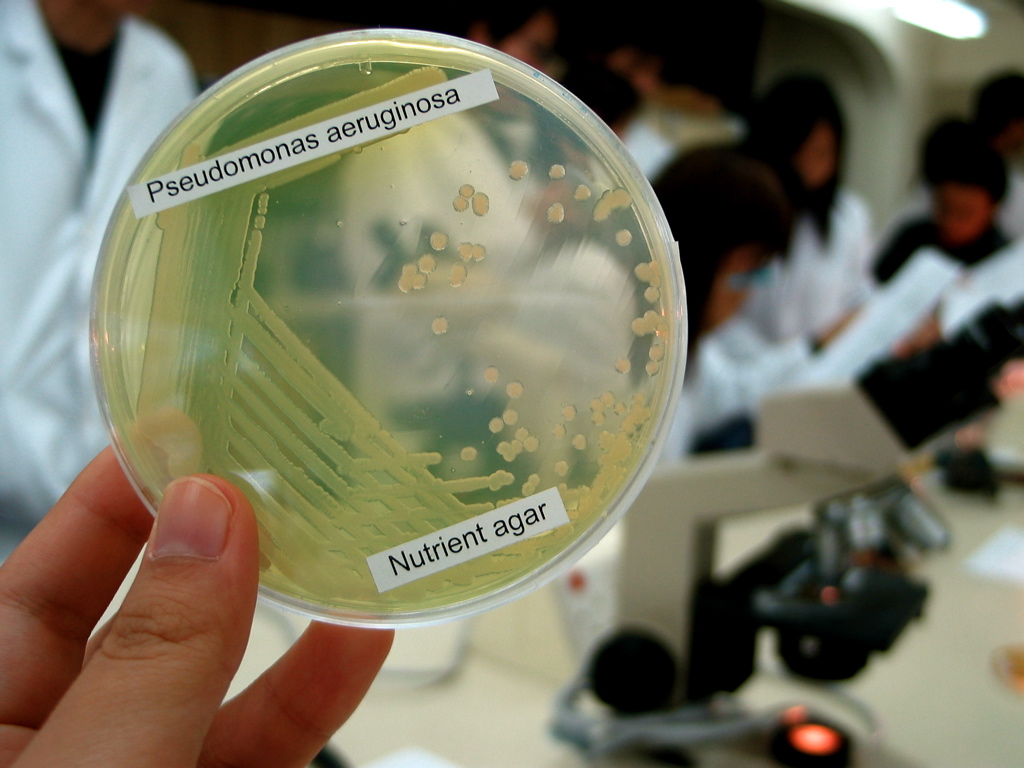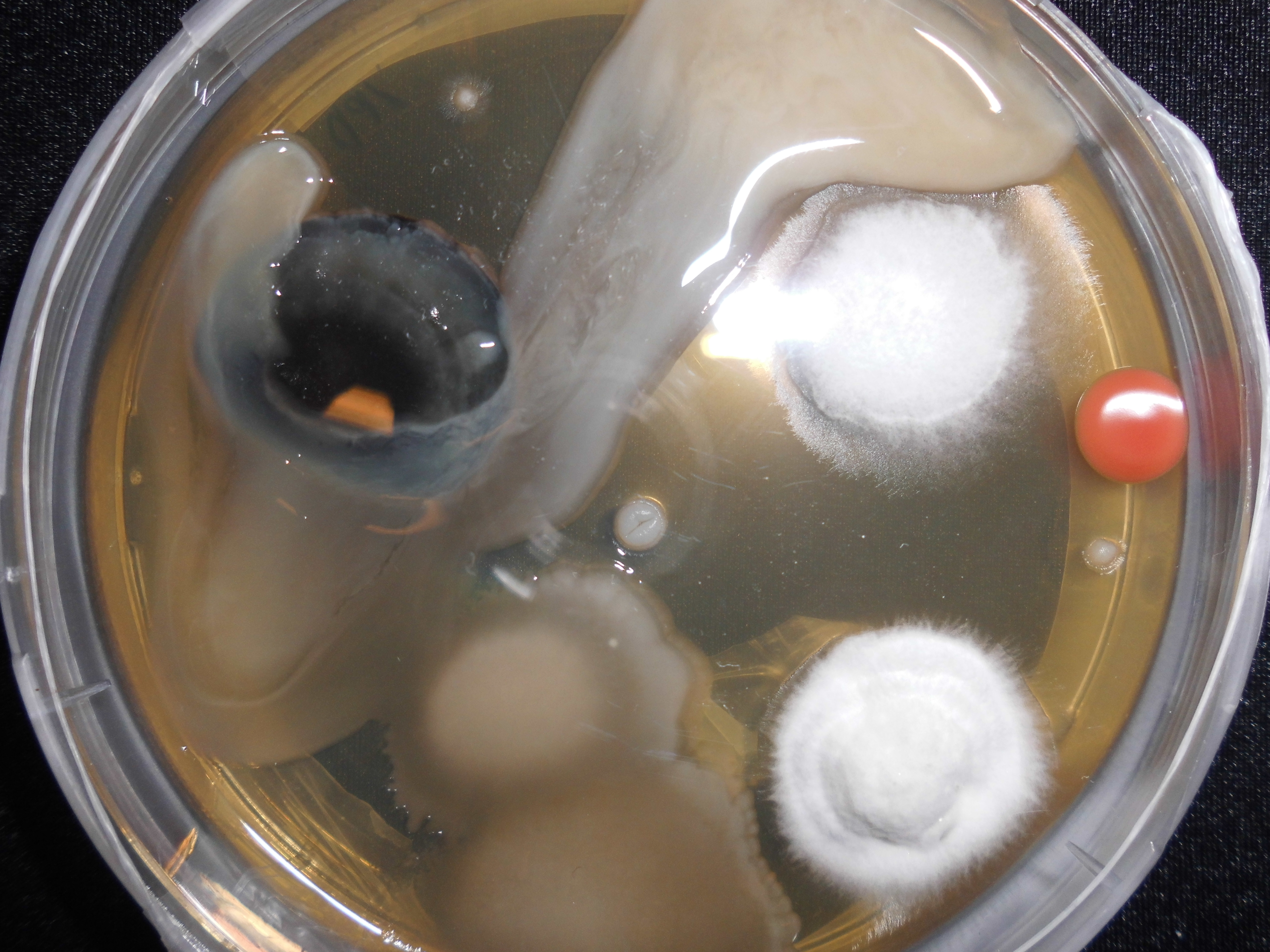|
Pseudomonas
''Pseudomonas'' is a genus of Gram-negative bacteria belonging to the family Pseudomonadaceae in the class Gammaproteobacteria. The 348 members of the genus demonstrate a great deal of metabolic diversity and consequently are able to colonize a wide range of niches and hosts. Their ease of culture ''in vitro'' and availability of an increasing number of ''Pseudomonas'' strain genome sequences has made the genus an excellent focus for scientific research; the best studied species include '' P. aeruginosa'' in its role as an opportunistic human pathogen, the plant pathogen '' P. syringae'', the soil bacterium '' P. putida'', and the plant growth-promoting '' P. fluorescens, P. lini, P. migulae'', and '' P. graminis''. Because of their widespread occurrence in water and plant seeds such as dicots, the pseudomonads were observed early in the history of microbiology. The generic name ''Pseudomonas'' created for these organisms was defined in rather vague terms by Walter Migula i ... [...More Info...] [...Related Items...] OR: [Wikipedia] [Google] [Baidu] |
Pseudomonas Aeruginosa
''Pseudomonas aeruginosa'' is a common Bacterial capsule, encapsulated, Gram-negative bacteria, Gram-negative, Aerobic organism, aerobic–facultative anaerobe, facultatively anaerobic, Bacillus (shape), rod-shaped bacteria, bacterium that can cause disease in plants and animals, including humans. A species of considerable medical importance, ''P. aeruginosa'' is a multiple drug resistance, multidrug resistant pathogen recognized for its ubiquity, its Intrinsic and extrinsic properties, intrinsically advanced antibiotic resistance mechanisms, and its association with serious illnesses – hospital-acquired infections such as ventilator-associated pneumonia and various sepsis syndromes. ''P. aeruginosa'' is able to selectively inhibit various antibiotics from penetrating its outer membrane'' ''– and has high resistance to several antibiotics. According to the World Health Organization ''P. aeruginosa'' poses one of the greatest threats to humans in terms of an ... [...More Info...] [...Related Items...] OR: [Wikipedia] [Google] [Baidu] |
Pseudomonadaceae
The Pseudomonadaceae are a family of bacteria which includes the genera '' Azomonas'', '' Azorhizophilus'', ''Azotobacter'', '' Mesophilobacter'', ''Pseudomonas'' (the type genus), and '' Rugamonas''. The family Azotobacteraceae was recently reclassified into this family. History Pseudomonad literally means false unit, being derived from the Greek ''pseudo'' ( – false) and ''monas'' (μονος – a single unit). The term "monad" was used in the early history of microbiology to denote single-celled organisms. Because of their widespread occurrence in nature, the pseudomonads were observed early in the history of microbiology. The generic name ''Pseudomonas'' created for these organisms was defined in rather vague terms in 1894 as a genus of Gram-negative, rod-shaped, and polar-flagellated bacteria. Soon afterwards, a large number of species was assigned to the genus. Pseudomonads were isolated from many natural niches. New methodology and the inclusion of approaches based on ... [...More Info...] [...Related Items...] OR: [Wikipedia] [Google] [Baidu] |
Pseudomonas Fluorescens
''Pseudomonas fluorescens'' is a common Gram-negative, rod-shaped bacterium. It belongs to the ''Pseudomonas'' genus; 16S rRNA analysis as well as phylogenomic analysis has placed ''P. fluorescens'' in the ''P. fluorescens'' group within the genus, Text was copied from this source, which is available under Creative Commons Attribution 4.0 International License to which it lends its name. General characteristics ''Pseudomonas fluorescens'' has multiple flagella, an extremely versatile metabolism, and can be found in the soil and in water. It is an obligate aerobe, but certain strains are capable of using nitrate instead of oxygen as a final electron acceptor during cellular respiration. Optimal temperatures for growth of ''P. fluorescens'' are 25–30° C. It tests positive for the oxidase test, and is also a nonsaccharolytic bacterial species. Heat-stable lipases and proteases are produced by ''P. fluorescens'' and other similar pseudomonads. These enzymes cause milk to ... [...More Info...] [...Related Items...] OR: [Wikipedia] [Google] [Baidu] |
Pseudomonas Syringae
''Pseudomonas syringae'' is a rod-shaped, Gram-negative bacterium with polar flagella. As a plant pathology, plant pathogen, it can infect a wide range of species, and exists as over 50 different pathovars, all of which are available to researchers from international culture collections such as the NCPPB, International Collection of Microorganisms from Plants, ICMP, and others. ''Pseudomonas syringae'' is a member of the genus ''Pseudomonas'', and based on 16S rRNA analysis, it has been placed in the ''P. syringae'' group. It is named after the lilac tree (''Syringa vulgaris''), from which it was first isolated. A phylogenomic analysis of 494 complete genomes from the entire ''Pseudomonas'' genus showed that ''P. syringae'' does not form a monophyletic species in the strict sense, but a wider evolutionary group that also included other species as well, such as ''P. avellanae'', ''P. savastanoi'', ''P. amygdali'', and ''P. cerasi''. ''Pseudomonas syringae'' tests negative for Ar ... [...More Info...] [...Related Items...] OR: [Wikipedia] [Google] [Baidu] |
-monas
The suffix -monas is used in microbiology for many genera and is intended to mean "unicellular organism". Meaning The suffix -monas found in many genera in microbiology is similar in usage to -bacter, -bacillus, -coccus or -spirillum. The genera with the suffix are not a monophyletic group and the suffix is chosen over -bacter, often simply out of stylistic preferences to match with Greek words. The first genus to be given the suffix -monas was ''Pseudomonas'', a genus of gammaproteobacteria. The generic epithet ''Pseudomonas'' was coined by Walter Migula in 1894, who did not give an etymology.Migula, W. (1900) System der Bakterien, Vol. 2. Jena, Germany: Gustav Fischer. Since the 7th edition of Bergey's manual (=top authority in bacterial nomenclature), other authors have given the etymology to be: Greek (, false) and (, single unit or monad), which can mean "false unit". However, "false unit" conceptually does not make much sense, namely, it does not mean "an organism which ... [...More Info...] [...Related Items...] OR: [Wikipedia] [Google] [Baidu] |
Last Common Ancestor
A most recent common ancestor (MRCA), also known as a last common ancestor (LCA), is the most recent individual from which all organisms of a set are inferred to have descended. The most recent common ancestor of a higher taxon is generally assumed to have been a species. The term is also used in reference to the ancestry of groups of genes (haplotypes) rather than organisms. The ancestry of a set of individuals can sometimes be determined by referring to an established pedigree, although this may refer only to patrilineal or matrilineal lines for sexually-reproducing organisms with two parents, four grandparents, etc. However, in general, it is impossible to identify the exact MRCA of a large set of individuals, but an estimate of the time at which the MRCA lived can often be given. Such ''time to most recent common ancestor'' (''TMRCA'') estimates can be given based on DNA test results and established mutation rates as practiced in genetic genealogy, or by reference to a non- ... [...More Info...] [...Related Items...] OR: [Wikipedia] [Google] [Baidu] |
Flagella
A flagellum (; : flagella) (Latin for 'whip' or 'scourge') is a hair-like appendage that protrudes from certain plant and animal sperm cells, from fungal spores ( zoospores), and from a wide range of microorganisms to provide motility. Many protists with flagella are known as flagellates. A microorganism may have from one to many flagella. A gram-negative bacterium '' Helicobacter pylori'', for example, uses its flagella to propel itself through the stomach to reach the mucous lining where it may colonise the epithelium and potentially cause gastritis, and ulcers – a risk factor for stomach cancer. In some swarming bacteria, the flagellum can also function as a sensory organelle, being sensitive to wetness outside the cell. Across the three domains of Bacteria, Archaea, and Eukaryota, the flagellum has a different structure, protein composition, and mechanism of propulsion but shares the same function of providing motility. The Latin word means " whip" to describe its ... [...More Info...] [...Related Items...] OR: [Wikipedia] [Google] [Baidu] |
Basionym
In the scientific name of organisms, basionym or basyonym means the original name on which a new name is based; the author citation of the new name should include the authors of the basionym in parentheses. The term "basionym" is used in both botany and zoology. In zoology, alternate terms such as original combination or protonym are sometimes used instead. Bacteriology uses a similar term, basonym, spelled without an ''i''. Although "basionym" and "protonym" are often used interchangeably, they have slightly different technical definitions. A basionym is the ''correct'' spelling of the original name (according to the applicable nomenclature rules), while a protonym is the ''original'' spelling of the original name. These are typically the same, but in rare cases may differ. When creating new taxonomic names, there are specific rules about how basionyms can be used. A new combination or name at new rank must be based directly on the original basionym rather than on any intermediate ... [...More Info...] [...Related Items...] OR: [Wikipedia] [Google] [Baidu] |
Agar Plate
An agar plate is a Petri dish that contains a growth medium solidified with agar, used to Microbiological culture, culture microorganisms. Sometimes selective compounds are added to influence growth, such as antibiotics. Individual microorganisms placed on the plate will grow into individual colony (biology), colonies, each a cloning, clone genetically identical to the individual ancestor organism (except for the low, unavoidable rate of mutation). Thus, the plate can be used either to estimate the concentration of organisms in a Microbiological culture, liquid culture or a suitable dilution of that culture using a colony counter, or to generate genetically pure cultures from a mixed culture of genetically different organisms. Several methods are available to plate out cells. One technique is known as "Streaking (microbiology), streaking". In this technique, a drop of the culture on the end of a thin, sterilization (microbiology), sterile loop of wire, sometimes known as an inocu ... [...More Info...] [...Related Items...] OR: [Wikipedia] [Google] [Baidu] |
Bergey's Manual Of Systematic Bacteriology
''Bergey's Manual of Systematic Bacteriology'' is the main resource for determining the identity of prokaryotic organisms, emphasizing bacterial species, using every characterizing aspect. The manual was published subsequent to ''Bergey's Manual of Determinative Bacteriology'', though the latter is still published as a guide for identifying unknown bacteria. First published in 1923 by David Hendricks Bergey, it is used to classify bacteria based on their structural and functional attributes by arranging them into specific familial orders. However, this process has become more empirical in recent years. The ''Taxonomic Outline of Bacteria and Archaea'' is a derived publication indexing taxon names from version two of the manual. It used to be available for free from the Bergey's manual trust website until September 2018. Michigan State University provides an alternative version that indexes NamesforLife records. The five-volume BMSB is officially replaced by ''Bergey's Manual of ... [...More Info...] [...Related Items...] OR: [Wikipedia] [Google] [Baidu] |
Ancient Greek
Ancient Greek (, ; ) includes the forms of the Greek language used in ancient Greece and the classical antiquity, ancient world from around 1500 BC to 300 BC. It is often roughly divided into the following periods: Mycenaean Greek (), Greek Dark Ages, Dark Ages (), the Archaic Greece, Archaic or Homeric Greek, Homeric period (), and the Classical Greece, Classical period (). Ancient Greek was the language of Homer and of fifth-century Athens, fifth-century Athenian historians, playwrights, and Ancient Greek philosophy, philosophers. It has contributed many words to English vocabulary and has been a standard subject of study in educational institutions of the Western world since the Renaissance. This article primarily contains information about the Homeric Greek, Epic and Classical periods of the language, which are the best-attested periods and considered most typical of Ancient Greek. From the Hellenistic period (), Ancient Greek was followed by Koine Greek, which is regar ... [...More Info...] [...Related Items...] OR: [Wikipedia] [Google] [Baidu] |

